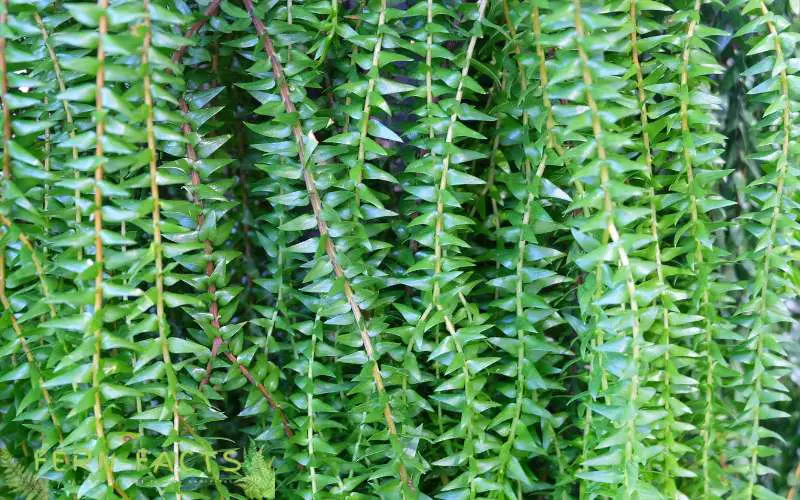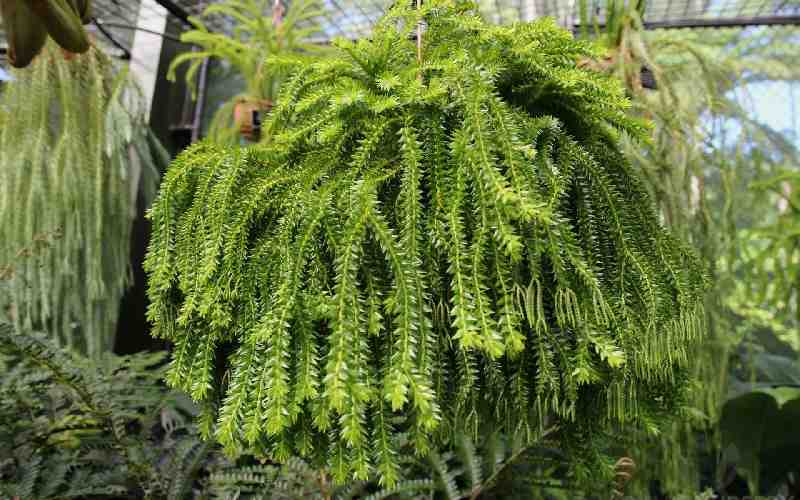All About Tassel Fern (Polystichum Polyblepharum)
Tassel ferns are known for their graceful arching glossy green fronds which complement one of the most elegant house plants over the decades. Similarly, they can be used as excellent ground cover in your garden as well.
That’s why if you have more queries on these ferns regarding their growing and caring tips, this article will show you a guiding path. Hence, I will give you all the information about Tassel ferns in this article so that you can grow and maintain these ferns in your house and give them thriving wild nature to nourish.
So let’s delve into the topic.

Overview of Tassel Fern
- Botanical name: Polystichum polyblepharum
- Common name: Tassel fern, Japanese tassel fern, Korean tassel fern, bristle fern, Japanese lace fern
- Family: Dryopteridaceae
- Genus: Polystichum
- Plant: Evergreen
- Soil type: sand, chalk, sand
- Soil pH: acidic, alkaline, neutral, well drained
- Flower: non-flower
- Shade: partial to full shade
- Native range: Japan and South Korea
- Height: around 2 to 3 ft (60 cm – 90 cm)
- Tolerance: Deer tolerance and rabbit
- Hardiness zone: 6,7,8,
Tassel ferns are elegant evergreen plants that form the shape of a lance with their dark green fronds. These ferns are mostly native to Japan and South Korea living in tropical moist areas.
They can grow up to 2 to 3 ft tall and around 3 ft wide if they get ideal conditions to live. These ferns can be great for bed borders, underplanting or undercover plants, rock gardens,s, and woodland gardens.
Additionally, these ferns prefer partial to full shade with a humid rich soil mixture. Besides, these tassel ferns also get the Garden Merit award from the Royal Horticultural Society because of their elegant qualities.
Keep the note that these tassel ferns are toxic to children and pets. So try to keep the plants away from any kind of incidents.
Tassel Ferns Care and Growing Tips
Similar to most ferns, tassel ferns also need ideal lighting, watering, soiling, fertilizing, and temperature to thrive in nature.
Light
Tassel ferns can grow actively in bright and indirect sunlight. Although they have the ability and tolerance level to tolerate sunlight, excessive sun rays can scorch their fronds.
Better you try to give them a partially bright place or in direct sunlight for them to bloom actively. You can keep them a maximum of 2 to 6 hr of full sunlight but not more than that.
However, Y can also keep them in a 2-hour deep shade without any sunlight.
Soil
Tassel ferns like organic soil with rich proponents which gives them nourishment from their roots. Therefore, you need to mix the soil with sand, chalk, or loam along with balancing the pH level between 4 to 7.
You can also use fertile or organic compost to enrich the soil texture. However, try to use well-drained soil so that the soil can drain out extra water.
Remember, well drained Soil is much needed for tassel ferns in order to prevent crown rot.
Water
Try to give them water on medium requirements since they don’t need excessive or less water. Both can be equally harmful to your tassel ferns. Thus, you can water them once a week.
Try to not keep the soil too dry or too soaked. You also apply a thumb technique method before pouring water on the plants. The goal should be to keep the soil moist and damp, not overly soaked.
Fertilizer
Tassel ferns prefer slow-release fertilizer to grow harmoniously. This slow release will be able to hold the enrichment of the soil by their steady release over the period of time.
Besides, you can fertilize your plants once a month during their growing seasons. Do not overfeed them because it can cause excessive salt burn to your plants.
Temperature and Humidity
Tassel ferns prefer a humid damp atmosphere around themselves. Therefore you can mist your houseplants if the room is not well humid.
Similarly, you can also place them in the bathroom or kitchen because those areas of the houses have more humidity than the other places.
Additionally, try to keep the temperature 15°C or 60°F so that your elegant evergreen tassel ferns can bloom.
Pruning
Although they don’t need much pruning and trimming, you can cut off their dead or brown fronds at the beginning of summer. Try to remove all the dead fronds before new ones unfurl.

How to Propagate Tassel Ferns
Propagation of tassel Ferns is another technique to have multiple plants from the mature plants. Let’s go through the process of Tassel ferns propagation.
Cutting Fronds
Tassel fern propagation can be done by cutting the fronds of the mature plants. However, these ferns take more or less one year to become mature plants. Before that, you can not do the propagation.
Thus, the appropriate time would be the beginning of summer. For this, you have to choose the mature plant and then precisely cut off 2 or 3 fronds from it. Later on, cover those fronds with a wet towel or tissue to give hydration. Then prepare the soil for planting.
You can choose fertile, compost, or organic matter as well. After that, place the fronds on the soil mixture and cover it with soil. Try to keep the soil moist and place them in a humid warm condition. You will notice roots will start to arise along with new green shoots.
Root Division
Another process is the root division process. You can also propagate tassel ferns by the root division method. In this process, take the main plants and loosen the soil from their pots. Then divide the plants from their rhizomes while ensuring both parts have equal amounts.
Later mix the soil with fertile or organic compost. After mixing the soil, plant the ferns in their individual pots and water the plants thoroughly.
Tassel Fern’s Pests and Diseases
Tassel ferns can be affected by mealybugs or scale most of the time. You will notice those pests on their stems. These insects and pests can eventually kill the plants if they are not terminated properly. Besides, you will notice yellow fronds because of pests and insects.
Therefore, you need to control those propels as soon as possible. Try to use pesticides and spray them on their fronds. Try to repeat the process every 10 days until all the pests are eradicated fully.
Alternatively, you can also use neem oil if you don’t want to use any chemical insecticides. Neem oil could be a suitable natural cure for these pests and problems.
Read More About How to Care for and Grow Wavy Cloak Fern.
Wrap up
To conclude this article, Tassel ferns mid size ferns that can grow well in a shady environment. Their greenery foliage will best ferns as houseplants or undercover plants in the garden.
Thus, by giving them an idea of light, temperature, soil, water, fertilizer, and propagation, you can grow these ferns in your house.
Similarly, by addressing their pests problems you can also give them healthy environments to thrive in your house.







